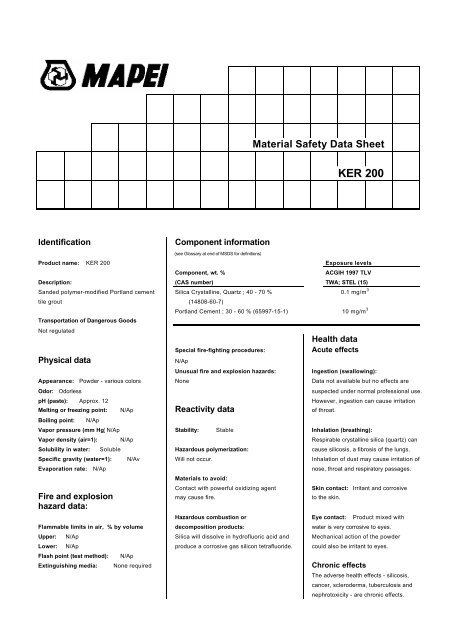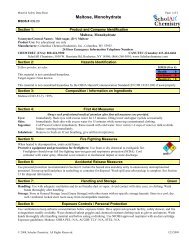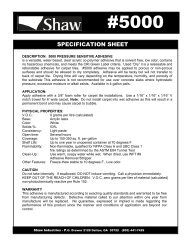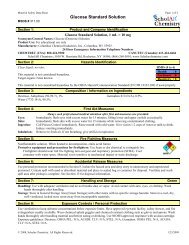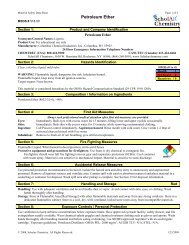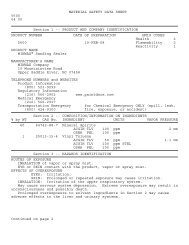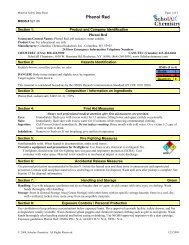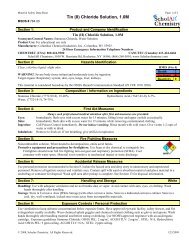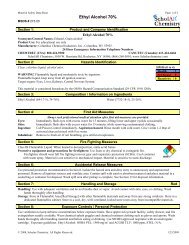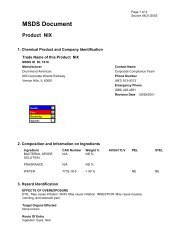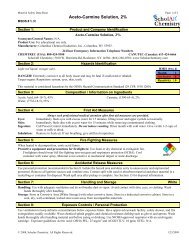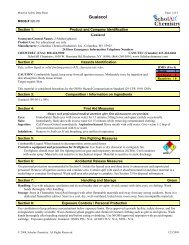Mapei KER 200.pdf
Mapei KER 200.pdf
Mapei KER 200.pdf
You also want an ePaper? Increase the reach of your titles
YUMPU automatically turns print PDFs into web optimized ePapers that Google loves.
Material Safety Data Sheet<br />
<strong>KER</strong> 200<br />
Identification<br />
Component information<br />
(see Glossary at end of MSDS for definitions)<br />
Product name: <strong>KER</strong> 200 Exposure levels<br />
Component, wt. %<br />
ACGIH 1997 TLV<br />
Description: (CAS number) TWA; STEL (15)<br />
Sanded polymer-modified Portland cement Silica Crystalline, Quartz ; 40 - 70 % 0.1 mg/m 3<br />
tile grout (14808-60-7)<br />
Transportation of Dangerous Goods<br />
Not regulated<br />
Physical data<br />
Portland Cement ; 30 - 60 % (65997-15-1) 10 mg/m 3<br />
Special fire-fighting procedures:<br />
N/Ap<br />
Unusual fire and explosion hazards:<br />
Health data<br />
Acute effects<br />
Ingestion (swallowing):<br />
Appearance: Powder - various colors None Data not available but no effects are<br />
Odor: Odorless suspected under normal professional use.<br />
pH (paste): Approx. 12 However, ingestion can cause irritation<br />
Melting or freezing point: N/Ap Reactivity data of throat.<br />
Boiling point:<br />
N/Ap<br />
Vapor pressure (mm Hg):N/Ap Stability: Stable Inhalation (breathing):<br />
Vapor density (air=1): N/Ap Respirable crystalline silica (quartz) can<br />
Solubility in water: Soluble Hazardous polymerization: cause silicosis, a fibrosis of the lungs.<br />
Specific gravity (water=1): N/Av Will not occur. Inhalation of dust may cause irritation of<br />
Evaporation rate: N/Ap nose, throat and respiratory passages.<br />
Materials to avoid:<br />
Contact with powerful oxidizing agent<br />
Fire and explosion may cause fire. to the skin.<br />
hazard data:<br />
Skin contact: Irritant and corrosive<br />
Hazardous combustion or Eye contact: Product mixed with<br />
Flammable limits in air, % by volume decomposition products: water is very corrosive to eyes.<br />
Upper: N/Ap Silica will dissolve in hydrofluoric acid and Mechanical action of the powder<br />
Lower: N/Ap produce a corrosive gas silicon tetrafluoride. could also be irritant to eyes.<br />
Flash point (test method):<br />
N/Ap<br />
Extinguishing media: None required Chronic effects<br />
The adverse health effects - silicosis,<br />
cancer, scleroderma, tuberculosis and<br />
nephrotoxicity - are chronic effects.
Product name: <strong>KER</strong> 200<br />
Carcinogenicity: Yes (International Preventive measures Special precautions<br />
Agency for Research on Cancer)<br />
Reproduction: N/Av Spill or leak procedures and storing:<br />
Precautions to be taken in handling<br />
Teratogenicity: N/Av Steps to be taken if material is Do not breath dust. Use adequate<br />
Mutagenicity: N/Av released or spilled: ventilation and dust collection. Keep<br />
Synergicity products: Smoking Use dustless methods (vacuum) and place into airborn dust concentration below TLV.<br />
closable container for disposal. Do not dry,<br />
sweep. Wear protective equipment specified.<br />
Practice good housekeeping. Do not<br />
permit dust to collect on walls, floors,<br />
sills, ledges, machinery or equipment.<br />
Emergency and Waste disposal method: Wash or vacuum clothing if dusty.<br />
first aid procedures<br />
Dispose in accordance to local<br />
Ingestion (swallowing):<br />
Do not induce vomiting. Contact<br />
a physician or a poison control center<br />
immediately.<br />
Inhalation (breathing):<br />
environmental regulation.<br />
Special protection<br />
information<br />
Respiratory protection:<br />
Wear an approved dust mask when the<br />
TLV is exceed and/or when the product is<br />
Move victim to fresh air. If not breathing, mixed with liquid. WHMIS Classification:<br />
trained pesonnel should administer aritificial Ventilation: The ventilation has to be<br />
respiration. Get immediate medical attention. sufficient enough to respect the TLV. D2A: Very toxic material causing other<br />
Skin contact:<br />
Protective gloves:<br />
Immediately wash skin with soap and water. Impervious / neoprene gloves E: Corrosive<br />
Remove contaminated clothing. Contact<br />
a physician if irritation persists.<br />
Eye contact:<br />
Flush eyes with water for at least 15 minutes<br />
while holding eyeslids open. Contact a<br />
physician.<br />
Eye protection:<br />
Safety glasses<br />
Other protective equipment:<br />
Apron is strongly recommended.<br />
effects than acute and immediate.<br />
Preparation information<br />
Prepared / revised by: Maria Teresa Neumann L.<br />
Date: September 13, 2000 (fg12b7)<br />
MAPEI INC.<br />
Glossary<br />
2900 Francis-Hughes<br />
ACGIH - American Conference of Government Industrial TLV - Threshold limit value Laval (Québec) H7L 3J5<br />
Hygienist TWA - 8 - hour time weighted average Telephone: (450) 662-1212<br />
CAS - Chemical Abstract Service STEL - Short-term exposure level: 15 min TWA Fax: (450) 662-0444<br />
OSHA - Occupational Safety and Health Administration (USA) N/Ap - Not applicable In Canada, (613) 996-6666 (Canutec)<br />
N/Av - Not available In USA, (800) 424-9300 (Chemtrec)<br />
The information contained herein is based on data considered accurate. However, no warranty is expressed or implied regarding the accuracy of these data or the results to be obtained from the use<br />
thereof. MAPEI INC. assumes no responsibility for personal injury or property damage to vendees, users, or third parties caused by the material. Such vendees or users assume all risks associated<br />
with the use of the material.


